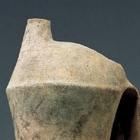J.J. Lally & Co., Oriental Art / New York City, New York
MenuPast Exhibition
Arts of Ancient China
March 27 - April 12, 2006
2.
A TALL NEOLITHIC POTTERY TRIPOD EWER
Longshan Culture, Erlitou Period, circa 1900-1700 B.C.
of thinly potted slender, roughly cylindrical form, standing on three hollow splayed legs, each with gently rounded sides tapering to a pointed foot, the domed top rising from a crimped edge, and surmounted by a short vertical tubular spout beside a wide oval knife-cut mouth with a deep notch pointed towards the top of the wide strap handle which extends all the way down the side to the top of one leg, decorated with a running band of inverted 'V' motifs flanked by widely spaced vertical grooves, carved into the flat surface of the handle, the underside of the handle joined to the body of the vessel by three narrow struts, the lower body embellished with a narrow band of crimped ‘piecrust’ decoration applied above the top of the legs as a decorative girdle, the pale tan-colored pottery with smooth surface showing remains of dark encrustation and buff earth from burial.
Height 23 7⁄8 inches (60.5 cm)
No other Neolithic pottery ewer of this very tall form with struts supporting the handle appears to have been previously published, but the overall design of the vessel, including the hollow tripod legs, the wide flat handle with incised surface decoration, and the domed cover with cut-out mouth and tubular spout are typical of pottery vessels excavated at Erlitou sites in Northern China, around the upper reaches of the Yellow River valley. Compare, for example, the tripod pottery ewer with domed top, incised strap handle and two bands of crimped ‘piecrust’ decoration, excavated at Erlitou and published in Erlitou Taoqi Jicui (Cream of the pottery from Erlitou), Beijing, 1995, p. 43, col. Pl. 6.
新石器時代 龍山文化 二里頭時期 長頸鬹 高 60.5 厘米
